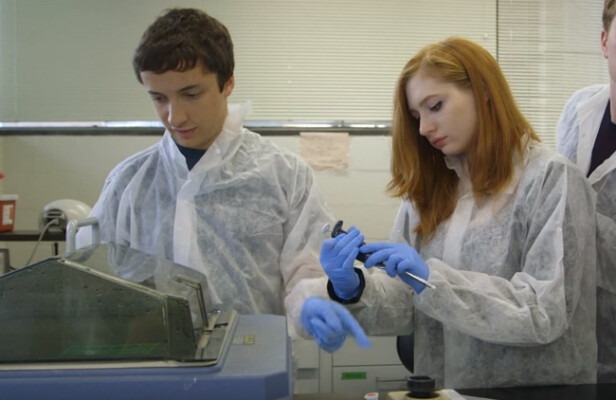Penn Biologists-in-training Used Genomic Techniques to Study Campus Microbes
The premier scientists at the University of Pennsylvania rely on next-generation sequencing techniques to elicit new information about the living world. Now, freshmen can do the same thing.
A new initiative in Penn’s Department of Biology, with support from the Office of the Vice Provost for Education, is putting cutting-edge genomic techniques in the hands of college students. As part of an introductory laboratory curriculum, offered to students in Biology 101 and Biology 123, more than 500 budding scientists formulated hypotheses, collected microbial samples on campus and analyzed them using next-generation DNA sequencing technology and bioinformatics techniques.
[youtube]FmByhggyDJk[/youtube]
“These two very large introductory biology classes are going out and sampling the built environment on Penn’s campus to determine what microbes we might be interacting with every time we cross campus, eat lunch or go sleep in the dorms,” says Karen Hogan, a teaching lab coordinator who, together with Linda Robinson, an adjunct assistant professor and lab coordinator in the Biology Department, designed the laboratory curriculum for this unit.
“It’s an inquiry-based experiment that uses new technology to answer a question about bacterial diversity in an environment,” says Robinson.
Students in the two courses divided into several lab sections and were given background information about metagenomics, which entails retrieving genetic information directly from biological samples collected in the environment. Metagenomics has been used to sample everything from the New York subway to food establishments to the human gut and can be used to contribute to investigations of disease, urban planning, forensics, bioterrorism and pollution remediation.
The instructors also gave students guidance in how to develop a testable hypothesis as well as instruction on sampling techniques. Then, students broke first into pairs and then larger groups to mull over potential hypotheses and sampling strategies.
Freshmen Tiffany Huang of Fremont, Calif., and Sunny Roy of Avon, Ohio, considered whether older college houses might have a different microbial makeup from newer buildings, or whether the presence of air conditioning might have an impact. Meanwhile, Ezra Brooks of Cherry Hill, N.J., wondered if bike racks near research labs would have a higher level of microbial species diversity than racks closer to campus housing.
Once larger groups agreed on a hypothesis to test, they set out for various spots around campus to sample, clad in blue gloves and carrying swabs and test tubes. In one campus building, Amanda Gross of Rockville, Md., Liqhwa Ncube of Bulawayo, Zimbabwe, and Daniel Fishman-Engel of San Francisco swabbed desks at public computer terminals. For Fishman-Engel, who is considering a major in the biological basis of behavior, it was his first direct experience with DNA sequencing.
“It’s exciting that my first time in lab I get to get my hands wet,” he says.
Another group dug up small soil samples from College Green and campus gardens to compare the microbial diversity between lawn and planting beds.
Certain campus features were more popular subjects for collection than others.
“I don’t think we should have been surprised that we got really, really good coverage of Ben on the Bench’s microbiome,” Hogan says, referring to the iconic statue of Benjamin Franklin just off Locust Walk.
In subsequent classes, the students extracted DNA from their samples, amplified a target gene and then sent the resulting mix for sequencing. The gene they focused on, which encodes 16s ribosomal RNA, has evolved slowly and thus contains key mutations that can distinguish and differentiate species from one another.
The output of a metagenomics assay can thus “determine the diversity of bacteria in each sample,” Robinson says.
When the sequencing information was made available to the students, they applied bioinformatics techniques, which rely on complex, computer-assisted analyses, to get a picture of the diversity of their samples and make headway in evaluating the validity of their hypothesis. To conclude the experience, the students presented their findings, both successes and failures, to their classmates.
“This is an incredibly special opportunity for our Penn students,” Hogan says. “It’s almost unheard of to attempt something like this at the scale that we’re doing it at with students who are this new in their academic career.”
If the experience is deemed a success, it may be emulated not only by future lab sections at Penn but perhaps also other universities.
“We have a lot of folks who are really excited to see how we pull it off so that they can implement it in their curricula in the future,” Hogan says.








